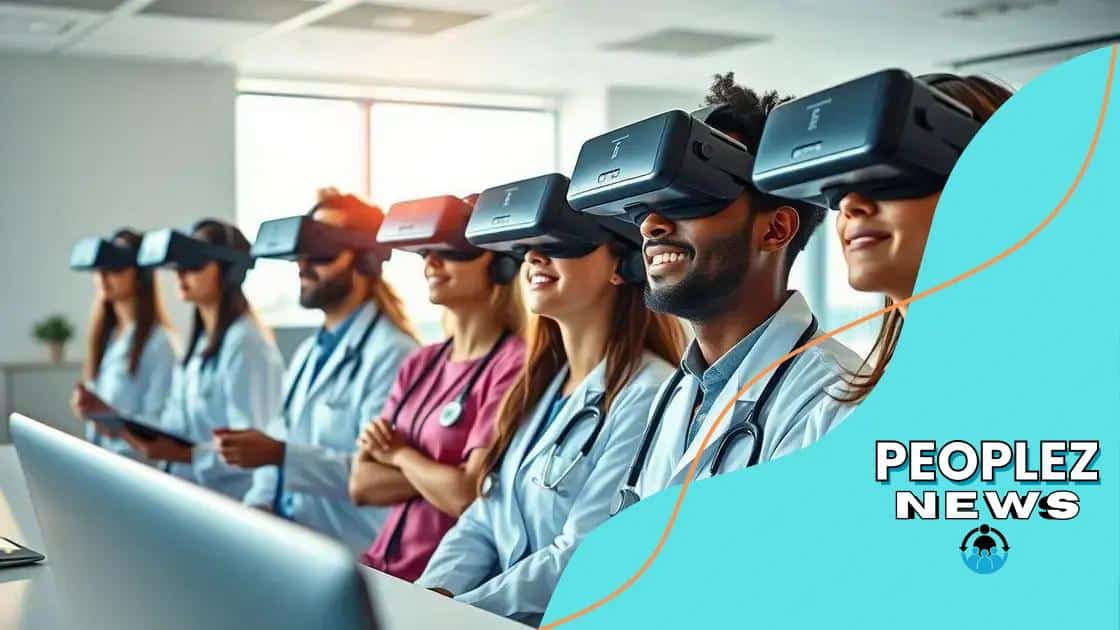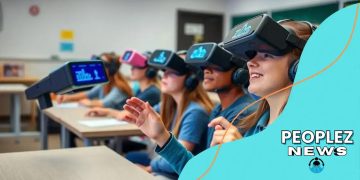Virtual reality used in immersive medical education

Virtual reality used in immersive medical education enhances training by providing realistic simulations, increasing student engagement, and allowing for safe practice of skills essential for future healthcare professionals.
Virtual reality used in immersive medical education is transforming how future healthcare professionals learn. By immersing students in realistic environments, they gain valuable experience that textbooks can’t provide. Curious about the advantages it brings? Read on to discover more.
Understanding virtual reality in education
Understanding virtual reality in education is crucial for harnessing its full potential. With the advent of technology, educational institutions are increasingly using VR to engage students in a more interactive way. This innovative approach not only enhances learning but also makes it enjoyable.
What is Virtual Reality?
Virtual reality refers to a simulated experience that can be similar to or completely different from the real world. In education, VR creates immersive environments where students can explore complex concepts hands-on. For example, a medical student can practice surgery in a lifelike setting, gaining experience without any risks.
Benefits of VR in Education
- Enhances engagement: Students are more motivated when learning through interactive experiences.
- Improves retention: Immersive learning helps students remember information better compared to traditional methods.
- Safe learning environment: VR simulations allow for practice in a risk-free setting.
Moreover, the versatility of VR applications means it can be utilized across various fields, from science and history to art and physical education. Students can virtually visit ancient civilizations or conduct chemistry experiments that would be too hazardous in real life.
This powerful tool not only nurtures creativity but also prepares students for real-world challenges. As colleges and universities continue to integrate virtual reality into their curricula, the future of education looks increasingly immersive and promising.
Applications of virtual reality in medical training
The applications of virtual reality in medical training are groundbreaking. By utilizing VR, educators can replicate real-life medical scenarios that are safe and controlled. Students can practice their skills in environments that mimic reality without the associated risks.
Types of Medical Training Using VR
In medical education, VR offers a range of uses that enhance learning experiences. One prominent application is surgical training. With virtual reality, surgeons can perform simulated operations, honing their techniques without endangering patients. This experience builds confidence and muscle memory, essential for success in the operating room.
Benefits of VR for Healthcare Professionals
- Realistic simulations: VR provides authentic scenarios that mimic real-life situations.
- Repetition and practice: Students can repeat procedures multiple times to improve their skills.
- Immediate feedback: Users receive instant evaluations to identify areas for improvement.
Another vital application of VR is in training for emergency situations. Medical professionals can practice how to respond to crises, like cardiac arrest or trauma cases. This training helps develop quick decision-making skills, which are crucial during real medical emergencies.
Moreover, VR also aids in patient education. By allowing patients to visualize their procedures or recovery processes, they can better understand what to expect. This transparency can reduce anxiety and improve overall patient satisfaction.
Benefits of immersive learning experiences

The benefits of immersive learning experiences are significant, especially in medical education. By engaging students in interactive environments, they can retain information more effectively. This method breaks the monotony of traditional learning and energizes the educational experience.
Enhanced Retention Rates
Research shows that learners who participate in immersive activities tend to remember information longer. When students interact with their lessons, they are more likely to form meaningful connections with the material. For example, participating in a virtual surgery session allows medical students to practice techniques actively, leading to better retention of skills and knowledge.
Increased Motivation and Engagement
- Active participation: Students are more engaged when they can interact directly with learning materials.
- Real-world connections: Immersive experiences relate classroom concepts to practical applications.
- Greater enthusiasm: Learning through virtual reality can create excitement and foster a love for the subject.
Furthermore, immersive learning experiences build confidence in students. By practicing in a controlled environment, they can make mistakes and learn from them without the fear of real-world consequences. This safe space encourages experimentation and critical thinking.
Moreover, the technology involved in VR and immersive experiences allows for personalized learning paths. Instructors can tailor experiences to fit individual learning styles and speeds, ensuring that all students grasp essential concepts before moving on to more complex topics. As learners find unique and engaging ways to absorb information, they develop skills that will serve them well in their future professions.
Challenges faced when implementing VR
Implementing virtual reality in education comes with various challenges that educators and institutions must address. These challenges can hinder the effectiveness of VR in the learning environment and may require innovative solutions.
Cost of Technology
The initial investment in VR technology can be significant. Schools need to purchase hardware, software, and necessary licenses, which can strain budgets. Even beyond the purchase, ongoing maintenance and upgrades are vital. It’s important for institutions to consider long-term costs versus short-term benefits when deciding to adopt VR.
Technical Limitations
- Hardware requirements: High-quality VR often requires powerful computers and specific setups that may not be available in all classrooms.
- Internet connectivity: Many VR applications need stable and fast internet connections to function smoothly.
- Software compatibility: Different systems may not support all VR applications, creating barriers to widespread use.
Moreover, there is a learning curve for both instructors and students when it comes to using VR technology. Training is often necessary to ensure that educators can effectively guide students through immersive experiences. This training can take time, which places additional pressure on schedules and resources.
Another critical aspect to consider is the potential for motion sickness among users. Some individuals may experience discomfort while using VR, which can affect their willingness to participate in immersive learning activities. Instructors must be aware of this and provide alternatives when needed.
Future trends in virtual reality for healthcare
The future trends in virtual reality for healthcare are promising and poised to revolutionize the way medical education and training are conducted. As technology advances, we can expect even more immersive and impactful experiences for both students and professionals.
Integration of AI and VR
One exciting trend is the integration of artificial intelligence (AI) with VR applications. This combination will allow for more adaptive learning experiences, enabling the technology to respond in real-time to user interactions. AI can analyze a learner’s performance, tailoring scenarios to fit their individual needs, thus enhancing the overall effectiveness of the training.
Increased Accessibility
As VR technology becomes more affordable, we will likely see increased accessibility in educational settings. More institutions will be able to invest in VR tools, making immersive learning experiences available to a broader range of students. This democratization of technology will level the playing field for those interested in healthcare careers.
Scenario-Based Learning
- Realistic simulations: Future VR experiences will feature even more realistic scenarios, replicating diverse situations healthcare professionals encounter.
- Collaboration tools: Teams can train together in virtual environments, promoting effective communication and teamwork skills.
- Remote education: VR will facilitate remote medical training, allowing instructors and students to connect from different locations.
Moreover, we can expect a shift towards more specialized training modules. As medical fields continue to evolve, the demand for focused VR experiences will grow. This will enable healthcare professionals to refine their skills in niche areas, such as telemedicine or specific surgical techniques.
Finally, user feedback will play a significant role in the evolution of VR in healthcare. Continuous improvements based on experiences from trainees will help tailor content to maximize learning outcomes, ensuring that VR remains an integral part of medical education.
FAQ – Frequently Asked Questions about Virtual Reality in Healthcare
How does virtual reality enhance medical training?
Virtual reality provides immersive simulations that allow students to practice procedures in a safe environment, improving their skills and confidence.
What are the main benefits of using VR in healthcare education?
The main benefits include increased engagement, improved retention of information, realistic practice scenarios, and personalized learning experiences.
What challenges are faced when implementing VR in educational settings?
Challenges include high costs, technical limitations, the need for training for both instructors and students, and potential motion sickness issues.
What future trends can we expect for VR in healthcare training?
Future trends include the integration of AI for adaptive learning, increased accessibility, and the development of specialized VR training modules.





